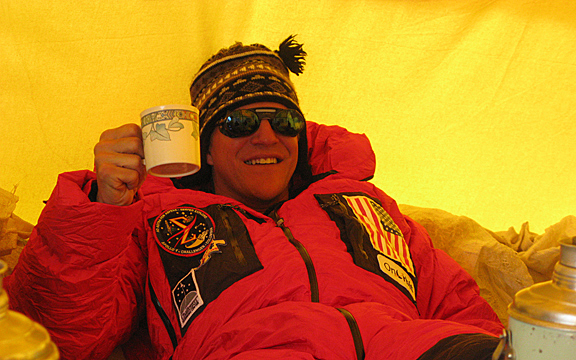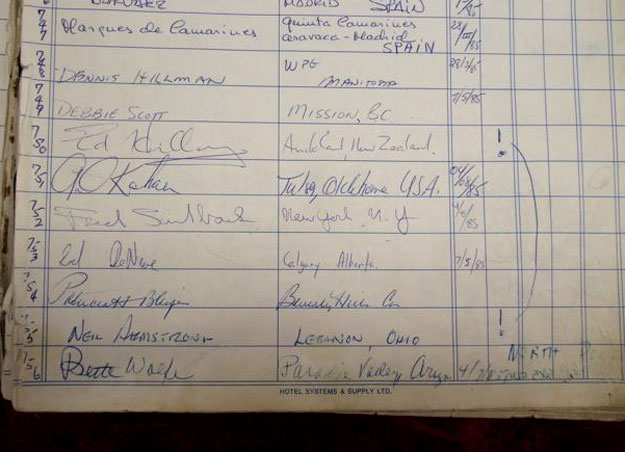Scott Parazynski: Everest Part Deux, in 3-D

Mount Everest is calling me again. A week from today I will begin to answer that call, my first step being a very long flight to Katmandu. Last spring, after 59 arduous days on the mountain, I came tantalizingly close to reaching the summit, but had to turn back due to a severe back injury. Since then my determination to reach the summit has only strengthened, and I am physically and mentally ready for another shot at it.
As I make this second summit bid, I hope to bring many of my friends – both old and new – along with me via this website. While this is a personal quest for me, in many ways, what I do – and how I do it – resonates with many other types of exploration, both on here on earth and in space. Therefore, I hope to use this climb to allow a wider audience, young and old alike, to gain some insight into how the business of exploration is done.
Close friends often give me a dazed and rather bewildered look when I tell them I’m going back to Everest this spring. “Didn’t you get close enough to the summit to call it good?” “Didn’t you blow out a disc in your back?” “Why would you want to go through all that suffering again?” The interrogation often continues, leading me to believe that some people just don’t get it: The challenge of Everest beckons me like no other, and a safe, round trip to the summit and back has been a daily focus since my fateful descent on May 21, 2008:
There I was, literally just 24 hours from standing atop the world’s tallest mountain, 6:30 am, May 21, 2008. The radio call from Casey had just come in, indicating that he, Ari, Danuru and Dawa had actually done it, and with extra determination I gave my pack a hoist, wincing in sharp pain in the process.
Just the day before I’d awoken with low back spasms (something I’ve dealt with intermittently in the past), but I had still managed to climb the very steep Lhotse face between Camps II and III in a very respectable four and a half hours, cinching my climbing harness like a weight lifter’s belt. The night at Camp II had been hard, unable to find a comfortable position for my low back for more than a minute or two. I told myself to persevere, the summit was tantalizingly close — by morning all would be well, else I’d just “ignore” the stabbing pain and press on to the top.
My buddies Adam, Kami, Namgya, Bob and others at camp were as helpful as friends could ever be under the circumstances — getting ready to move up to Camp IV for our summit assault — placing a fresh oxygen cylinder in my backpack and installing the crampons on my boots (there was no way I’d have been able to reach them. With their encouragement I braced myself and led off up the steep slope towards the Yellow Band on a test run. Within 10 paces I did an about face and told my friends “I’m done,” averting my wet eyes from probably some of theirs. I knew that if I continued up with them I’d slow them dramatically, possibly compromising their summit success, and conceivably place them in a rescue situation (mine). After 59 days on this expedition, and a lifetime of dreaming about it, it was a painful but easy decision to turn away from the summit…
For some people, the cliche “the cup is half full” applies. For others it chronically appears empty. But for me the cup usually sits at three quarters full – or better. I’m a realist, but with a generally optimistic spin. I have carefully thought through a return to the mountain this year. I know with certainty that I am physically, technically and mentally capable of summiting and descending safely. That is, provided several “ifs”: the weather cooperates; I can stay healthy, hydrated and well nourished; the route and our provisioning at high camps comes together as planned; and I keep the proper focus on personal and team safety.
Ask any of my teammates from last season and they’d tell you I had the right stuff for the summit: I was climbing efficiently and quite fast, thanks to my wonderful Sherpa friend, Kami. I had acclimatized well and I had stayed healthy for the most part (everyone gets the “Khumbu cough” to a certain extent). I had kept up with my calories and fluids as well as could be hoped (I still ended up losing 25 lbs when it was all said and done, however), and I had placed a premium on safety for myself and those around me. What I was lacking last year was plain old luck — but I do have ample tenacity and a very strong sense that 2009 is the year I’ll see the top!
I used to compete in a sport called Luge, a winter Olympic event on ice that some would say is a bit crazy – yet I know it to be one of the most exciting on Earth. Luge requires bursts of strength, navigating steep banked curves at speeds up to 85 miles an hour and 6-g’s of acceleration, all while keeping your head back as far as possible for the best aerodynamic cut down the track.
I remember one evening run in particular on the Lake Placid Olympic track. It was nearly 40 degrees below zero. Coupling in the wind chill, the equivalent temperature was -60 degrees F. At the start I was shivering . Just 45 seconds later, at the finish line, my heart was racing at 160 beats per minute and I was panting and sweating from the intense effort.
We could only do 3 or 4 runs each training session, both because of the wear and tear on our bodies, and because of the set up time between runs for every member of the team. In between runs on the track, we would lie down on a bench in the start house and “previsualize” ourselves going down the track, turning our heads and shoulders into the imagined curve, pulling in the opposite leg to drive a perfect (fast) line down the track. With practice, we would drive our imaginary course in almost exactly the same amount of time as when we launched off of the real start handles.
This has been a long digression, but I have previsualized my every step of the way up and down Everest, and I intend to follow up with the real thing in the coming 6-8 weeks! Please join me, Sherpa Danuru (who will be my climbing sidekick this season — much more about him later), Keith Cowing, Miles O’Brien and the NASA trekking team as we undertake this epic adventure!








